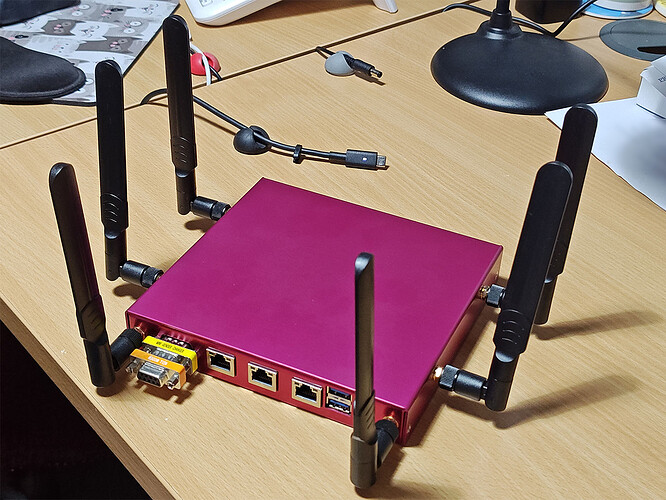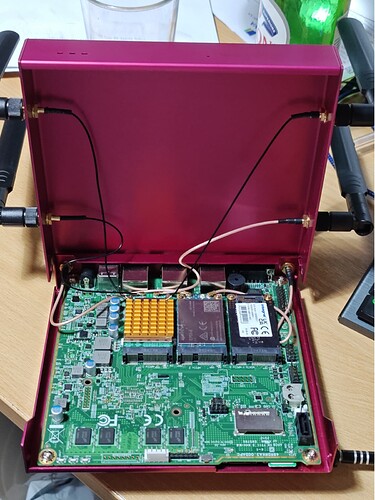Frankenbox lives ![]()
So thats why I couldnt buy an SMA aerial.![]()
what’s the RS232 for, nostalgia ![]()
Console and the only way of communicating with the board when there’s no OS on there - so more-or-less essential to bootstrapping an OS onto it.
Almost all commercial WiFi access points/routers still have a serial console port hidden inside, even now.
Ahh, my era ![]() (and also my Omex box in the Morgan)
(and also my Omex box in the Morgan)
Is that gender changer plus DTE/DCE changer ?
I have no idea what it is but I love the colour ![]()
Are those little glue on cable tidies? Where did you get those? ![]()
What’s it do that an off the shelf modem/WAP can’t?
Amazon sell them. Self adhesive. You can also get weighted ones if you need to move them around.
Yup - gender changer and null modem, which then plugs into a Prolific PL2303 based USB/RS232 adapter to talk to the PC
Also in blue ![]() silver
silver ![]() and black
and black ![]()
Though the one with 6 pre-drilled holes for SMA antennae only comes in red (more a dark pink, as you have probably noticed).
Amazon, as noted by @hairbear
No, well I have now - but it is moderately obvious that you could do something like that with an R Pi and a WiFi module (as far as I can see it isn’t intended to support LTE modems though I believe 4G/5G modules are available for the Pi).
That’s kind-of complex to answer.
In terms of basic functionality not much, it’s about on par with Free’s 4G box for example. In some ways arguably less as there’s no “bundled” TV and it’s limited to 4G as I haven’t found a compatible 5G modem yet.
However - and probably only really appreciated by geeks, and open source geeks at that - the platform is completely flexible and runs on open source software from the bios/bootloader up. Oh, and full schematics are available if I need them.
It is based on an AMD embedded SoC, the GX-412TC which is a quad core 64 bit chip running at up to 1.4GHz (sadly now withdrawn by AMD so the board I’m using is also EoL though there is still supply in the channel).
The practical upshot of which is that I can run just about any OS which runs on an Intel processor and doesn’t mind that there is no GPU (which rules out Microsoft offerings, even their “Windows IoT” versions AFAIK - I’m not feeling any great sense of loss).
At present it’s dual boot Fedora Server and OpenWRT but the former is mainly for debugging - OpenWRT is more “router oriented” but there’s also pfSense for the BSD crowd, any flavour of Linux that you like and multiple open source and commercial embedded/real time operating systems.
However OpenWRT is a good match as I want a router/firewall.
But even sticking with OpenWRT there are a huge number of packages available - web servers, telephony, VPN, adblockers, UPS interfaces, file and media servers, print servers, email servers, databases, cloud storage server, network security tools, ddns, home automation servers, and much more.
Also I can guarantee regular security and functionality updates - I have absolutely no idea if Orange have ever updated the software in the Livebox, for example.
So it’s about flexibility, transparency and control of the software running on my devices.
Yes obvs I knew about the individual tools but I’d not seen before that there’s a specific distro with them all installed already.
Ah good point about LTE modem support, I don’t know about that.
Thanks for that, now everything’s totally clear to us non-geeks.
The “front” two are supposedly 4/5G the side 4 are WiFi.
Not that I can see any difference, I’m half tempted to buy another two of each and crack them open to see if there are any differences at all.
The focus is on WiFi after all.
I thought about using an R Pi - I have quite a few lying around having bought a batch cheap ages ago (made a nice profit when availability fell through the floor thanks to Covid).
However I have a bunch of R Pi 3’s which have a few limitations, one being that their Ethernet is actually USB based - I don’t think that they have enough performance for the job.
I’m not sure if I could use a Pi for the whole project - you can get 4G or 5G modules but I’m less sure about the WiFi module - the Pi has WiFi built in and you can even use it as an access point but it’s not exactly a cutting edge multi-stream setup.
I can see adapters that let you use a minipcie card - but then you have to get the card.
Which is not straightforward - few cards actually allow use as an access point, some do but only on 2.4Ghz so you need to check the fine print. I settled on an AW7915-NP1 from AsiaRF but that seems to be about the only one around at the moment. Certainly the Intel AX210 cards (in fact, as I understand it, any Intel WiFi card) cannot be used in “AP mode”.
Ideally there would be four minipcie slots - the board has one for msata, one for LTE cards and one for WiFi - which leads on to another bit of fine print to read.
Despite the name minipcie can carry PCIe (one lane), SATA, USB 2, an I2C bus and/or connections for a SIM card. SATA and PCI are exclusive as they use the same pins for different functions - so you need to know what bus(ses) you card needs and what bus(ses) your motherboard provides.
Anyway for simultaneous 2.4GHz and 5GHz you need two WiFi cards - well, you could use the AW7915-NPD which has a 2.4GHz radio and a 5GHz radio which can be used concurrently but it only offers two streams.
The AW7915-NP1 is a MIMO card supporting 4 streams - it seems pretty good in tests so far with my phone reporting a raw connection speed over 1Gbps, it’s pretty close though.
As for the WLAN performance I’m getting ~30Mbps down ~10Mbps up (at home in the UK) which is consistent with my phone and *thats* on 5G - but to the same MVNO.
Back to the Pi - AIUI you can’t have multiple “hats” so can’t easily have a better WiFi module plus an LTE module, so I don’t think it’s straightforward to build a 4/5G “hotspot”.
What?? Surely my explanation is crystal clear and non techy?
To be fair most are not geeks and the interest in building your own 4G “box” is stricctly limited - but the letter has gone to Orange now so I need something to give us an Internet connection in the house. When we’re away in France is about the only time we are relaxed/not hassled by work enough to catch up on what Prime has to offer ![]()
Would it not be easier to swap them over and check the effect on signal strength?
Unfortunately performance is too affected by surroundings and minor changes in position produce quite large changes in reported signal strength and quality so making a meaningful comparison without specialised measuring equipment is probably impossible.
Of course the flip side of that argument is that it might not actually matter if they are, in fact, the same internally.
Very fancy and impossible to achieve in one box “off the shelf” unless you have some handy person build you a bespoke one.
Usually two people as you don’t often find someone that understands both the radio and IP side of the isle, though that was changing when I left telecoms as radio is just another transport layer for packets these days.
“Antennae careth not about which “G” be printed on ye packaging, for verily, such “G”s are the invention of dullards and matter not to gentlemen of science.” Shakespeare.
When shopping for antennae, you need to know the following:
- Frequency band
- Gain (dBi)
- Maximum input power
- How directional they are as both receiving and transmitting elements (good ones give you those radiation plots)
Quite
However that’s not how these things are typically sold so 4G/5G or WiFi are convenient labels to describe the products.
WiFi operates around 2.4GHz (2.401 to 2.483GHz), 5GHz (5.15-5.895GHz) and 6GHz (5.925-7.125Ghz) - not counting odd frequency bands that are only used in a couple of countries and/or in restricted circumstances.
LTE operates in numerous bands from 400MHz to just under 6GHz (mostly, there are higher frequency bands as well but I don’t think they are generally used yet).
Bands in use in the EU are B1(2.1GHz), B3(1.8GHz), B7(2.6GHz), B8(900MHz), B20(800MHz), B28(700MHz), B32(1.5GHz), B38(2.6GHz) and B40(2.3GHz).
So there is rather a lot of overlap.
My suspicion is that anything sold as an “4/5G” or “WiFi 6/7” antenna will be be a multi-element microstrip design covering frequencies up to about 7GHz with a fairly flat response and it will work reasonably well whether for LTE or WiFi.
Anything sold simply as a “WiFi” antenna might well be an older design and only really tuned for the 2.4 & 5GHz bands and it will be a matter of dumb luck whether it is any good in an LTE setting.
As for the dubious “gain” figures - gain in an antenna is relative (compared with an isotropic radiator for dBi, or a dipole for dBd) and can only be achieved by narrowing the radiation volume - typically WiFi antennae have a toroidal radiation pattern - so roughly a flat disk perpendicular to the antenna - there’s a tendancy for most people to assume “more dBi = betterer” but in reality it just means the torroid is squashed more vertically so you might see the signal go up (if you are roughly in the antenna’s horizontal plane) or go down (if you are above or below that plane).
It’s complex stuff, mostly a dark art and I don’t profess anything other than the most basic knowledge of what is going on ![]()


